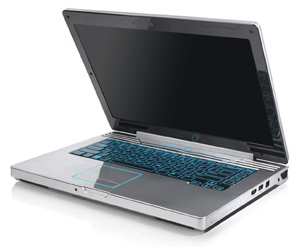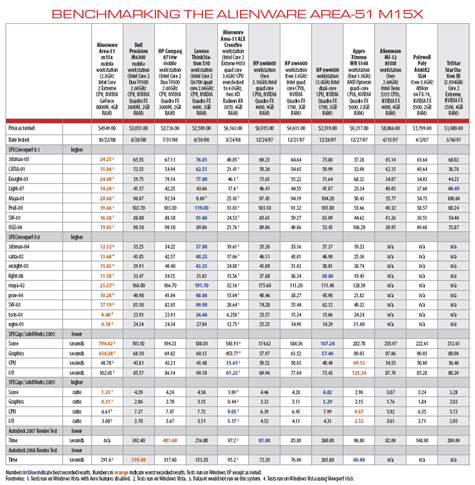Alienware Mobile Costly for Its Performance
The popular gaming system manufacturer releases the Area-51 m15x mobile workstation with designs on the MCAD world.
Latest News
December 4, 2001
By David Cohn
 Nothing Sigourney Weaverish about it, the Alienware Area-51 m15x mobile workstation might bestylish, but is ultimately modest in its Silver Ripley configuration. |
We’ve reviewed several Alienware systems in the past, the most recent being the high-end Area-51 ALX Crossfire (see July 2008 DE). But this time around, the Florida-based manufacturer of high-performance gaming and professional systems (actually owned by Dell) sent us its top-of-the-line 15.4-inch Area-51 m15x mobile workstation. Designed to deliver the ultimate mobile gaming experience, the system is the first 15.4-inch notebook equipped with an Intel Core 2 Extreme CPU and NVIDIA GeForce graphics accelerator. The big question was whether this gaming system could double as a professional MCAD workstation.
The Alienware Area-51 m15x measures 14.5 in. x 10.62 in. x 1.75 in. and weighs in at 7.75 pounds (a bit lighter than the recently reviewed Dell M6300, Nov. 2008 DE). The power supply adds an additional 1.75 pounds. Unlike the other-worldly appearance of the Alienware Area-51 ALX Crossfire workstation, with the case closed the Area-51 m15x doesn’t look that different from other 15.4-inch notebook computers. Housed in a shiny silver plastic case — referred to as its “Silver Ripley Design” — the only thing that sets this computer apart from other notebooks is the raised alien head logo on the outside of the case.
Upon raising the lid and powering up the system, however, things quickly change. The alien head glows white while the Alienware name (below the LCD display) glows cool blue. The black 86-key keyboard, which appears to float above a large palm rest and touch pad, also glow as do the quick touch controls above the keyboard and a “light pipe” ring around the outside of the upper portion of the case. These backlight colors can be changed using the AlienFX lighting control software, which lets you set different color combinations and even lets you control the flashing of the lights to alert you of new e-mails and other events.
Quick-touch buttons above the keyboard let you control power, speaker volume, WiFi, and Bluetooth, as well as access the Alienware Control Center application (for lighting and power settings) and to switch the system into stealth mobile battery mode, which reduces power consumption to a maximum of 65 watts for maximum battery life. The touch pad appears to have just a single button, but actually has separate left and right sensitivity zones. There is no fingerprint reader.
 Click here for a PDF of the Benchmarks. |
Our evaluation unit came equipped with a WideUXGA display with a native resolution of 1920 x 1200 with 1200p HDTV resolution support. Alienware also offers a WXGA+ (1440 x 900) display as a lower-cost option. The display was powered by an NVIDIA GeForce 8800M GTX graphics accelerator with 512MB of dedicated graphics memory.
Other graphics card options include the GeForce 8600M, 8700M, and 9800M as well as the NVIDIA Quadro FX 1600M. All of these cards support DirectX 10, but only the Quadro FX is certified for use with most MCAD and DCC applications.
Alienware also offers several SATA-based storage options, including 5400rpm hard drives up to 500GB, 7200rpm drives up to 320GB, and a 128GB solid-state drive. Our evaluation unit came with a 7200rpm 320GB Seagate Momentus drive. Alienware also included a 2X dual layer Blu-Ray/DVD±RW/CD-RW burner, making the Area-51 m15x the first Blu-Ray equipped system we’ve ever reviewed. Other less-expensive optical drive options include an 8X dual layer CD-RW/DVD±RW drive, a similar drive with LightScribe technology, and a drive with Blu-Ray read capability but only DVD/CD burning options. The optical drives can also be swapped out for a second hard drive or extra battery.
Expansion options on the Alienware Area-51 m51x are a bit more limited than on some of the other mobile workstations we’ve reviewed. Along the right size of the case are a 7-in-1 media card reader (SD/MS/MSPRO/MMC), an Express Card slot, and HDMI, FireWireB, and a single USB port. There’s also a security lock slot. The left side of the system includes the optical drive bay, microphone and headphone jacks, two more USB ports, RJ45 network port, and the power connector. The system’s 6-cell lithium ion battery extends across the rear of the case. Our evaluation unit lasted a disappointing 1 hour and 20 minutes on our battery run-down test in spite of switching to stealth battery mode and turning down the LCD backlight.
A panel on the bottom of the system provides access to the hard drive, video card, CPU, and memory. Here you’ll also find the battery lock and a voltage indicator, but there is no provision for a docking station. The system also includes both Bluetooth and WiFi via an Intel PRO Wireless 4965 b/g/n mini-card as well as the integrated Gigabit Ethernet, but the system lacks a modem. The 7/1/5.1 digital high-definition audio system powers a pair of built-in speakers positioned above the keyboard. There’s also a 2-megapixel webcam and dual microphone array built into the bezel above the LCD. Those wishing to connect to an external monitor will need to purchase the optional HDMI to DVD-D adapter ($20).
| Alienware Area-51 m15x >Price: $4,549 as tested ($1,499 base price) >Size: 14.5 in. x 10.62 in. x 1.75 in. (WxDxH) notebook >Weight: 7.75 pounds plus power supply (depending on configuration) >CPU: 2.8GHz Intel Core 2 Extreme (X9000) w/6MB L2 cache >Memory: 4GB (4GB max) >Graphics: NVIDIA GeForce 8800M GTX w/512MB memory >LCD: WUXGA 1920 x 1200 >Hard Disk: 320GB, 7200rpm SATA >Floppy: none >Optical: 2X dual layer Blu-Ray/DVD±RW/ CD±RW burner >Audio: microphone and headphone jacks >Network: integrated Gigabit Ethernet, Intel PRO Wireless 4965 b/g/n wireless LAN >Bluetooth: Integrated 2.0 >Modem: none >Other: Three USB 2.0, one IEEE 1394b (9-pin) FireWire, ExpressCard slot (54mm), HDMI out (DVI-D adapter optional), 7-in-1 card reader (SD/MS/ MSPRO/MMC), 2-megapixel webcam, 2-microphone array >Keyboard: integrated 86-key keyboard >Pointing device: integrated touchpad |
Benchmarks Hampered by Vista
Alienware offers the Area-51 m15x with several different CPUs ranging from a 2.1GHz Intel Core 2 Duo up to the Intel Core 2 Extreme X9000 2.8GHz CPU included in our evaluation unit. That processor features an 800MHz front side bus and 6MB of L2 cache. The base system comes with 1GB of dual-channel DDR 2 memory, but Alienware equipped our system with the maximum capacity of 4GB of 667MHz memory installed as a pair of 2GB SO-DIMMs.
To determine the performance capabilities of this Alienware notebook computer, we ran our standard set of benchmark tests, including SPECviewperf to measure graphics performance and the SPECapc benchmark for SolidWorks to gauge how the computer performs running a typical MCAD application. We also ran our AutoCAD rendering test.
Although Alienware offers Windows XP Professional as a $100 option, our system came with Windows Vista Home Premium installed. As a result, we ran SPECview-perf 10.0 instead of 9.1. When run at 1280 x 1024 in single-thread mode, the results from SPECviewperf 10.0 should be comparable to 9.1. We also ran SPECviewperf 8.1 so that readers can compare results to systems we’ve tested in the past. In both cases, the Area-51 m15x turned in the lowest SPECviewperf scores we’ve ever recorded. But those results weren’t unexpected, considering the fact that under Vista, all graphics must go through the Aero interface before reaching the display.
When we turned out attention to the SPECapc SolidWorks benchmark, which is more of a real-world test (and breaks out graphics, CPU, and I/O performance separately from the overall score), the results were better but still not stunning. While the overall and graphics scores still placed this Alienware laptop at the bottom among all current systems we’ve reviewed, the CPU and I/O scores were somewhat better.
The AutoCAD rendering results were right where we expected them to be. Since the Mental Ray rendering engine in Auto- CAD is multi-threaded, this test clearly shows the benefits of multiple CPUs. So the Intel Core 2 Extreme CPU in the Alienware Area-51 m15x appeared as two CPUs, with rendering tasks spread between them. At 2.8GHz, the Alienware laptop edged out the 2.6GHz Dell M6300 mobile workstation we recently tested.
Alienware offers a standard one-year warranty with 24/7 phone support. Two- and three-year warranties are also available. The company includes an AlienRespawn data-recovery disc that restores the system to its original shipped configuration in the event of a mishap.
Prices start at $1,499 for an Area-51 m15x with a more sedate CPU, less memory, smaller hard drive, and more modest graphics card. As equipped, our evaluation system would set you back $4,549, a lot to pay for this level of performance. To be more seriously considered as an MCAD workstation, we’d opt for the NVIDIA Quadro FX 1600M graphics board and Windows XP, but those options would drive the price up an additional $700. We think there are better choices for those looking for a stylish yet powerful portable workstation than the Alienware Area-51 m15x.
More Info:
Alienware
Miami, FL
Contributing Editor David Cohn is a computer consultant and technical writer based in Bellingham, WA, and has been benchmarking PCs since 1984. He’s the former Editor-in-Chief of Engineering Automation Report and CADCAMNet, and the author of more than a dozen books. Please send comments about this article to [email protected]. You can also contact David at [email protected].
Subscribe to our FREE magazine, FREE email newsletters or both!
Latest News
About the Author
David Cohn is a consultant and technical writer based in Bellingham, WA, and has been benchmarking PCs since 1984. He is a Contributing Editor to Digital Engineering, the former senior content manager at 4D Technologies, and the author of more than a dozen books. Email at [email protected] or visit his website at www.dscohn.com.
Follow DE





